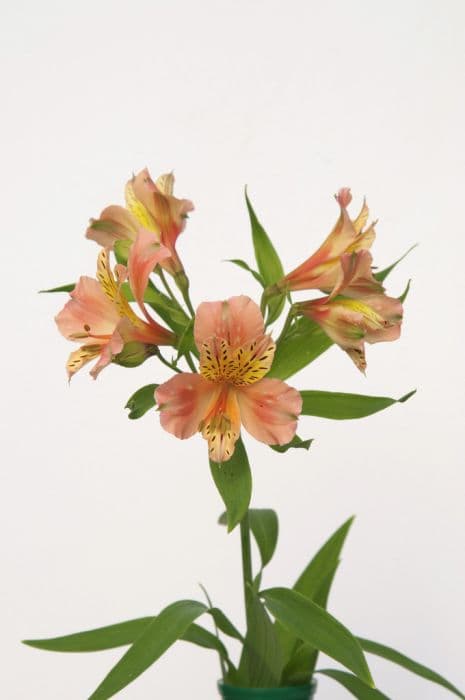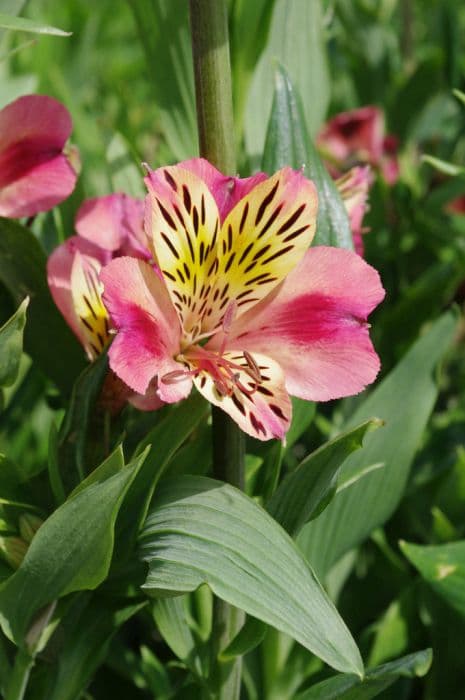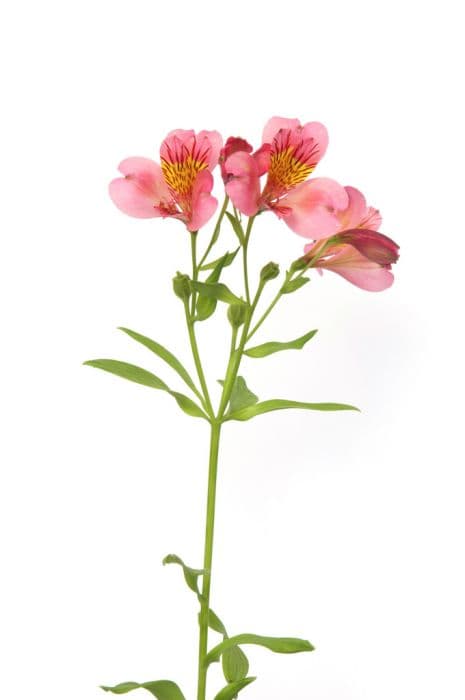Peruvian Lily Alstroemeria Princess Theresa = 'Zapriteres' (PBR) (Princess Series)

ABOUT
Alstroemeria Princess Theresa, also commonly known as Peruvian Lily or Lily of the Incas, is a captivating plant with striking features. It stands out for its resplendent flowers that boast an alluring color palette. The blossoms exhibit a mix of deep pink and creamy white hues, which can sometimes vary towards a soft yellow, with each petal distinctly edged in a contrasting shade that enhances its appeal. A notable characteristic is the speckled or streaked markings, often in darker pink or purplish tones, that embellish the inner segments of the petals, adding texture and depth to the flower's appearance. The petals are typically arranged in a funnel-like or trumpet-shaped fashion, contributing both to the elegance of the individual flowers and to the overall ornamental quality of the floral cluster. Each bloom clusters along the top of sturdy stems, creating a showy display that can be densely packed or more loosely arranged, depending on the individual plant's habit. Adding to the allure are the lance-shaped leaves that array along the stems. The foliage of the Peruvian Lily is bright green, sometimes with a glossy texture, and their slender, elongated form gracefully accompanies the vibrant flowers. Together, the blossoms and foliage create a lush, textured look that is both full and vibrant, making Alstroemeria Princess Theresa a sought-after plant for gardens and floral arrangements.
About this plant
 Names
NamesFamily
Alstroemeriaceae
Synonyms
Peruvian Lily, Lily of the Incas, Parrot Lily
Common names
Alstroemeria Princess Theresa = 'Zapriteres' (PBR) (Princess Series).
 Toxicity
ToxicityTo humans
The plant commonly known as Peruvian Lily is not considered highly toxic to humans. However, it can cause mild irritation if ingested. Handling the plant may also cause skin irritation due to its sap, which contains compounds that some individuals might be sensitive to. Ingestion usually doesn't cause more than minimal discomfort, such as nausea or a mild upset stomach.
To pets
The Peruvian Lily is known to be mildly toxic to pets, particularly cats and dogs. If pets ingest this plant, they may experience symptoms such as vomiting, diarrhea, and abdominal pain. In some cases, contact with the sap can lead to dermatitis or skin irritation. While it is not usually life-threatening, ingestion of the Peruvian Lily can cause discomfort and should be avoided. If a pet consumes a significant amount of the plant, it is advisable to consult a veterinarian.
 Characteristics
CharacteristicsLife cycle
Perennials
Foliage type
Deciduous
Color of leaves
Green
Flower color
Pink
Height
2-3 feet (60-90 cm)
Spread
2 feet (60 cm)
Plant type
Herb
Hardiness zones
7
Native area
South America
Benefits
 General Benefits
General Benefits- Long Blooming Season - Alstroemeria, commonly known as Peruvian Lily, often blooms from late spring to early fall, providing prolonged color and interest in the garden.
- Vibrant Colors - Peruvian Lilies are known for their vivid and varied colors, with 'Zapriteres' offering unique and striking flower patterns that enhance garden aesthetics.
- Cut Flower Use - Due to their long vase life and beautiful flowers, they are excellent for cut flower arrangements, adding a touch of elegance to interiors.
- Attracts Pollinators - Peruvian Lilies can attract butterflies and hummingbirds, promoting pollination and contributing to a healthy garden ecosystem.
- Drought Tolerance - Once established, they are relatively drought-tolerant, requiring less frequent watering and care than some other garden plants.
- Easy to Grow - They are not particularly demanding regarding soil conditions, making them a good choice for gardeners of all skill levels.
- Compact Growth Habit - With a compact and clumping growth habit, they are suitable for small gardens or borders without taking too much space.
- Cold Hardy - Alstroemeria Princess Theresa is cold hardy in certain climates, allowing for growth in a range of garden zones.
 Medical Properties
Medical PropertiesThis plant is not used for medical purposes.
 Air-purifying Qualities
Air-purifying QualitiesThis plant is not specifically known for air purifying qualities.
 Other Uses
Other Uses- Artistic inspiration: Alstroemeria can serve as a muse for artists and photographers due to its striking colors and unique patterns, offering a natural subject for paintings, drawings, and photography portfolios.
- Educational tool: Botany and horticulture teachers may use Alstroemeria in lessons about plant biology, hybridization, and cultivation techniques to demonstrate real-world applications of scientific concepts.
- Cake decoration: The edible blooms of the Alstroemeria can be used as natural, decorative, and non-toxic embellishments for cakes and pastries, adding a floral charm to confectioneries.
- Color dye source: The pigments in Alstroemeria petals can be used to extract natural dyes for fabric, crafting eco-friendly and unique textile patterns.
- Perfumery: Although not a common source, the subtle fragrance of Alstroemeria flowers might be used in the creation of light, floral perfumes or scented candles for a delicate aroma.
- Thematic landscaping: Alstroemeria can be incorporated into garden designs that aim to represent specific themes such as 'royalty' or 'princesses,' given its regal appearance and association with the name Princess Theresa.
- Symbolic gift: Beyond their beauty, Alstroemeria can be gifted to convey a wide range of messages, from friendship and devotion to strength and perseverance, due to their diverse symbolism in the language of flowers.
- Journaling and scrapbooking: Dried Alstroemeria petals can be used in scrapbook layouts or as bookmarks, providing a tactile and visually appealing element to journal entries and personal diaries.
- Cultural events and festivals: Alstroemeria can be incorporated into floral arrangements and decorations for cultural celebrations and festivals, contributing to the vibrancy and thematic decoration of the events.
- Film and stage props: The flowers can be used in set design for films, theatre, and television to create authentic-looking garden scenes or floral bouquets as props.
Interesting Facts
 Feng Shui
Feng ShuiThe Peruvian Lily is not used in Feng Shui practice.
 Zodiac Sign Compitability
Zodiac Sign CompitabilityThe Peruvian Lily is not used in astrology practice.
 Plant Symbolism
Plant Symbolism- Friendship: Alstroemerias, commonly known as Peruvian Lilies, often symbolize strong bonds of friendship due to their twisted leaves, which represent the interwoven nature of relationships.
- Devotion: The Alstroemeria flower is a symbol of enduring devotion between partners, as the flowers are known for their longevity and the ability to bloom throughout the year.
- Wealth and Prosperity: With its lush, full blossoms, the Peruvian Lily is also a symbol of wealth and prosperity, often used in bouquets and arrangements to convey a wish of abundance to the recipient.
- Fortune: The presence of multiple blooms on each stem of the Peruvian Lily can represent a multiplication of fortune, making these flowers a positive token for those starting new ventures.
- Achievement: The intricate petals of the Alstroemeria can symbolize the complexity and achievement of success, making them appropriate gifts for graduations or professional accomplishments.
 Water
WaterThe Peruvian Lily should be watered thoroughly once the top inch of the soil feels dry to the touch. It's important to water the plant deeply, which can typically mean using about 1-2 gallons of water for an outdoor plant or 16-32 ounces for a potted plant indoors or in a sheltered area, depending on its size and the pot's volume. During the growing season in spring and summer, this might translate to watering once every week, but always adjust to the moisture level of the soil and the weather conditions. In winter, reduce watering to every other week or less, as the plant's water requirements decrease with cooler temperatures and dormancy.
 Light
LightPeruvian Lilies thrive in bright, indirect light when grown indoors, or in full sun to partial shade outdoors. The best spot provides morning sunlight and protection from the intense heat of the afternoon sun, especially in hotter climates. These lighting conditions support vibrant blooms and healthy growth.
 Temperature
TemperaturePeruvian Lilies perform best in temperatures between 65-80 degrees Fahrenheit. They can survive minimal exposure to temperatures as low as 23 degrees Fahrenheit, but for optimal growth, maintaining warmer conditions is recommended. Extended exposure to temperatures above 90 degrees Fahrenheit can stress the plant and necessitate additional care.
 Pruning
PruningPeruvian Lilies benefit from pruning to remove spent flowers and encourage further blooming. Prune by gently pulling the spent stem from the base to promote new growth. The best time for pruning is after a bloom cycle has finished and anytime dead or damaged foliage is present. Regular deadheading during the blooming season can enhance the plant's appearance and vigor.
 Cleaning
CleaningAs needed
 Soil
SoilAlstroemeria, commonly known as Peruvian Lily, thrives best in fertile, well-draining soil with a pH range of 6.5 to 7.5. A high-quality potting mix amended with compost and perlite would create an optimal environment for healthy growth.
 Repotting
RepottingPeruvian Lilies should be repotted every two to three years to refresh the soil and address any potential root crowding. Repot in the spring before the growing season begins.
 Humidity & Misting
Humidity & MistingPeruvian Lilies prefer moderate humidity levels, consistent with typical indoor environments. Aim to maintain relative humidity around 40-50% for optimal growth conditions.
 Suitable locations
Suitable locationsIndoor
Place Peruvian Lilies in bright indirect light, keep soil moist but not waterlogged.
Outdoor
Peruvian Lilies require sun to partial shade, shelter from strong winds, and well-draining soil.
Hardiness zone
7-10 USDA
 Life cycle
Life cycleAlstroemeria 'Zapriteres', popularly known as the Peruvian Lily, starts its life as a dormant rhizome or seed. Upon germination, roots and shoots develop, leading to the establishment of a vegetative plant with lush, green foliage. As it matures, the plant enters the flowering stage, showcasing colorful, trumpet-shaped blooms that attract pollinators. After pollination, seeds are produced within capsules, which eventually dry and release seeds, completing the reproductive cycle. During unfavorable conditions, especially colder months, the plant may enter dormancy, with above-ground parts dying back, while the rhizome survives underground. With the arrival of favorable growing conditions, typically in spring, the Alstroemeria 'Zapriteres' resumes growth, starting the life cycle anew with fresh vegetative growth and subsequent flowering.
 Propogation
PropogationPropogation time
Spring-Early Summer
Alstroemeria Princess Theresa, commonly known as Peruvian Lily, is often propagated through division, which is the most popular method. This process is best performed in late winter or early spring before the plant begins its active growth. To propagate, carefully lift the clump from the ground with a shovel, avoiding damage to the tubers. Once out of the ground, gently tease apart the clump into smaller sections, ensuring each division has one or more shoots and a portion of the root system. Replant these divisions immediately at the same soil depth they were previously growing, spaced approximately 12 to 18 inches (30 to 45 centimeters) apart to allow for ample growth. Water the new plants thoroughly to help establish them. This division helps to rejuvenate the plant and promote vigorous growth, while effectively multiplying your Peruvian Lilies.




![Peruvian lily [H.R.H. Princess Alice]](/_next/image?url=https%3A%2F%2Fplants-admin.emdemapps.com%2Fimages%2Fplants%2F%2Fimages%2F604b55e81c8b0.png&w=640&q=75)
![Peruvian lily [Indian summer]](/_next/image?url=https%3A%2F%2Fplants-admin.emdemapps.com%2Fimages%2Fplants%2F%2Fimages%2F604b616bc746b.png&w=640&q=75)
![Peruvian lily [Inticancha Creamy Dark Pink]](/_next/image?url=https%3A%2F%2Fplants-admin.emdemapps.com%2Fimages%2Fplants%2F%2Fimages%2F604b5e98bea7c.png&w=640&q=75)
![Peruvian lily [Inticancha Imala]](/_next/image?url=https%3A%2F%2Fplants-admin.emdemapps.com%2Fimages%2Fplants%2F%2Fimages%2F604b619b522ba.png&w=640&q=75)
![Peruvian lily [Inticancha Red]](/_next/image?url=https%3A%2F%2Fplants-admin.emdemapps.com%2Fimages%2Fplants%2F%2Fimages%2F604b5aebac273.png&w=640&q=75)
![Peruvian lily [Inticancha Sunday]](/_next/image?url=https%3A%2F%2Fplants-admin.emdemapps.com%2Fimages%2Fplants%2F%2Fimages%2F604b646146dd9.png&w=640&q=75)